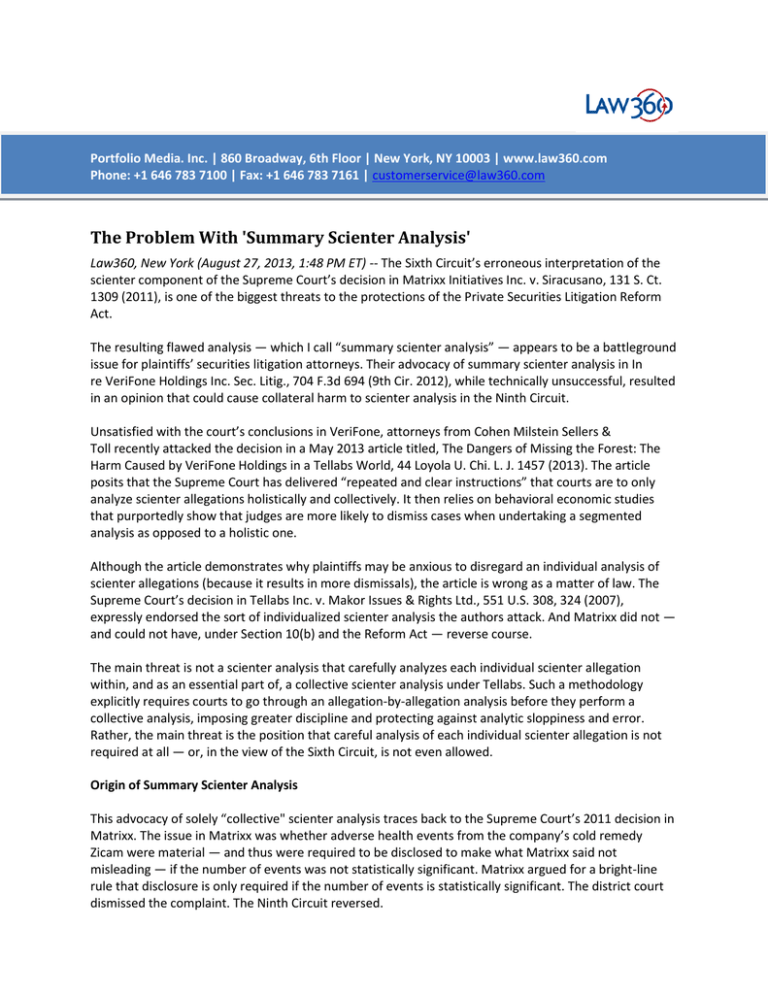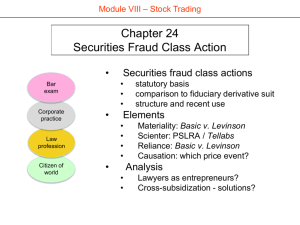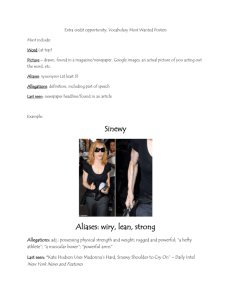The Problem With 'Summary Scienter Analysis'
advertisement

Portfolio Media. Inc. | 860 Broadway, 6th Floor | New York, NY 10003 | www.law360.com Phone: +1 646 783 7100 | Fax: +1 646 783 7161 | customerservice@law360.com The Problem With 'Summary Scienter Analysis' Law360, New York (August 27, 2013, 1:48 PM ET) -- The Sixth Circuit’s erroneous interpretation of the scienter component of the Supreme Court’s decision in Matrixx Initiatives Inc. v. Siracusano, 131 S. Ct. 1309 (2011), is one of the biggest threats to the protections of the Private Securities Litigation Reform Act. The resulting flawed analysis — which I call “summary scienter analysis” — appears to be a battleground issue for plaintiffs’ securities litigation attorneys. Their advocacy of summary scienter analysis in In re VeriFone Holdings Inc. Sec. Litig., 704 F.3d 694 (9th Cir. 2012), while technically unsuccessful, resulted in an opinion that could cause collateral harm to scienter analysis in the Ninth Circuit. Unsatisfied with the court’s conclusions in VeriFone, attorneys from Cohen Milstein Sellers & Toll recently attacked the decision in a May 2013 article titled, The Dangers of Missing the Forest: The Harm Caused by VeriFone Holdings in a Tellabs World, 44 Loyola U. Chi. L. J. 1457 (2013). The article posits that the Supreme Court has delivered “repeated and clear instructions” that courts are to only analyze scienter allegations holistically and collectively. It then relies on behavioral economic studies that purportedly show that judges are more likely to dismiss cases when undertaking a segmented analysis as opposed to a holistic one. Although the article demonstrates why plaintiffs may be anxious to disregard an individual analysis of scienter allegations (because it results in more dismissals), the article is wrong as a matter of law. The Supreme Court’s decision in Tellabs Inc. v. Makor Issues & Rights Ltd., 551 U.S. 308, 324 (2007), expressly endorsed the sort of individualized scienter analysis the authors attack. And Matrixx did not — and could not have, under Section 10(b) and the Reform Act — reverse course. The main threat is not a scienter analysis that carefully analyzes each individual scienter allegation within, and as an essential part of, a collective scienter analysis under Tellabs. Such a methodology explicitly requires courts to go through an allegation-by-allegation analysis before they perform a collective analysis, imposing greater discipline and protecting against analytic sloppiness and error. Rather, the main threat is the position that careful analysis of each individual scienter allegation is not required at all — or, in the view of the Sixth Circuit, is not even allowed. Origin of Summary Scienter Analysis This advocacy of solely “collective" scienter analysis traces back to the Supreme Court’s 2011 decision in Matrixx. The issue in Matrixx was whether adverse health events from the company’s cold remedy Zicam were material — and thus were required to be disclosed to make what Matrixx said not misleading — if the number of events was not statistically significant. Matrixx argued for a bright-line rule that disclosure is only required if the number of events is statistically significant. The district court dismissed the complaint. The Ninth Circuit reversed. In an opinion by Justice Sonia Sotomayor, the Supreme Court unanimously affirmed the Ninth Circuit, with most of the opinion devoted to the holding on the primary issue on appeal: statistical significance is not required to trigger a duty to disclose adverse events if what the company said is rendered misleading by the omission, or disclosure is otherwise required by law. That ruling meant that Matrixx made material misrepresentations by virtue of omitting the adverse events from its public statements. Following the materiality analysis, the Supreme Court’s affirmance of the Ninth Circuit’s scienter ruling was straightforward. The Supreme Court articulated Tellabs’ scienter standard, without altering it in any way. Then, applying Tellabs, the court considered defendants’ nonculpable explanation: consistent with the lack of statistical significance, the adverse events were not a problem, and thus any misleading statements were not made with intent to defraud. The court found the culpable explanation of the allegations more compelling. The allegations detailed instances of Matrixx’s concern about the events, such as hiring a consultant and convening a panel of physicians and scientists on the matter. And, “[m]ost significantly, Matrixx issued a press release that suggested that studies had confirmed that Zicam does not cause anosmia [loss of smell] when, in fact, it had not conducted any studies relating to anosmia and the scientific evidence at that time, according to the panel of scientists, was insufficient to determine whether Zicam did or did not cause anosmia." 131 S. Ct. at 1324. In other words, the complaint alleged a misrepresentation that was either intentional or highly reckless. The vast majority of the commentary about the Matrixx decision concerned the materiality ruling. The scienter holding did not appear to break any new ground — at least until the Sixth Circuit held that it did. In Frank v. Dana Corp., 646 F.3d 954, 961 (6th Cir. 2011), the Sixth Circuit reversed the district court’s dismissal of the plaintiffs’ complaint. In analyzing the complaint’s scienter allegations, the court noted that its Reform Act decisions had analyzed complaints “by sorting through each allegation individually before concluding with a collective approach” under Tellabs. But the court decided to “decline to follow that approach in light of the Supreme Court’s recent decision in Matrixx …,” which the Sixth Circuit said “provided for us a postTellabs example of how to consider scienter pleadings ‘holistically’ … Writing for the Court, Justice Sotomayor expertly addressed the allegations collectively, did so quickly, and, importantly, did not parse out the allegations for individual analysis.” 646 F.3d at 961. But Matrixx was not concerned with the proper methodology of scienter analysis under Tellabs. Indeed, its comments on scienter were almost an afterthought. The court did not hold — or even suggest — that the “quick[]” way it addressed the scienter allegations was the required method of analysis. Its analysis presumably was “quick[]” because it didn’t need to be lengthy, given the nature of the allegations, the secondary nature of the scienter issue in relationship to the disclosure issue, and the procedural setting, i.e., a review of a scienter finding by the Ninth Circuit. Thus, the Sixth Circuit read into Matrixx a holding that the court didn’t reach. To date, only the Tenth Circuit has endorsed the Sixth Circuit’s misreading of Matrixx — with a holding that seems to include a dangerous endorsement of “conclusory” scienter analysis. See In re Level 3 Communications Inc. Securities Litig., 667 F.3d 1331 (10th Cir. 2012) (“While its analysis was conclusory, the district court was under no duty to catalog and individually discuss the reports and witnesses plaintiff described.”) (citing Dana). But the plaintiffs certainly caught the Ninth Circuit’s attention with their summary-scienter-analysis argument in In re VeriFone Holdings Inc. Sec. Litig., 704 F.3d 694, 703 (9th Cir. 2012). Following the Supreme Court 2007 decision in Tellabs, the Ninth Circuit had evaluated its prior cases and decided on a two-step approach to scienter analysis: courts must first analyze scienter allegations individually, and then analyze them collectively. Zucco Partners LLC v. Digimarc Corp., 552 F.3d 981, 991-92 (2009). In VeriFone, the Ninth Circuit rejected the argument that Matrixx prohibits its two-step analysis: “Matrixx on its face does not preclude this approach and we have consistently characterized this twostep or dual inquiry as following from the Court’s directive in Tellabs.” 704 F.3d at 703. The court then reviewed other appellate decisions, and held that “[b]ecause the Court in Matrixx did not mandate a particular approach, a dual analysis remains permissible so long as it does not unduly focus on the weakness of individual allegations to the exclusion of the whole picture.” Id. Yet the VeriFone court then decided to skip the first step (a review of each individual allegation to determine if any of them itself is sufficient to plead scienter) and, instead, to “approach this case through a holistic review of the allegations,” though it emphasized that “we do not simply ignore the individual allegations and the inferences drawn from them.” Id. It found that the allegations — which included allegations of multiple significant accounting manipulations directed by the individual defendants — holistically sufficed to plead scienter. Although the Ninth Circuit correctly understood that Matrixx did not alter the Tellabs scienter standard, its willingness to abandon an explicit two-step scienter analysis is an unfortunate consequence of the incorrect interpretation of Matrixx advanced by the plaintiffs. The result is the implicit endorsement of an approach that could yield a more cursory analysis of individual scienter allegations by district courts. This is troubling, because scrutiny of each scienter allegation, to understand and weigh it in relationship to each challenged statement, allows a court to properly weigh the allegations collectively. Without such scrutiny, there is a risk that courts will under- or over-value one or more of the individual allegations and thus spoil the collective analysis. To the extent that they allow (or require) district courts to stray from this particularized analysis, both Dana and VeriFone are incorrect, because individual scrutiny of scienter allegations is required by the controlling law: Tellabs and the two statutes at issue, Section 10(b) and the Reform Act. Scienter Analysis under Tellabs The Tellabs court began its analysis by announcing several “prescriptions” about scienter analysis under the Reform Act. The second prescription is that “courts must consider the complaint in its entirety, as well as other sources courts ordinarily examine when ruling on Rule 12(b)(6) motions to dismiss, in particular, documents incorporated in the complaint by reference, and matters of which a court may take judicia notice.” 551 U.S. at 322. The court’s third prescription is that “courts must take into account plausible opposing inferences.” The court noted that “[t]he strength of an inference cannot be decided in a vacuum. The inquiry is inherently comparative. How likely is it that one conclusion, as compared to others, follows from the underlying facts?” Id. at 323. In order to conduct this analysis, the court expressly contemplated analyzing individual scienter allegations, and indeed itself analyzed two types of individual allegations: financial motive, and knowledge of falsity. Tellabs contended that the lack of a financial motive for fraud was dispositive. The court held that financial motive is a factor to be considered among other considerations. Consideration of financial motive, in turn, requires an examination of stock sales and their context to determine whether they add up to a sufficient motive. This, of course, amounts to scrutiny of individual allegations. Tellabs also contended that the complaint’s allegations were too vague and ambiguous to plead knowledge of falsity. The court agreed that “omissions and ambiguities count against inferring scienter,” though reiterated that courts must consider such shortcomings in light of the complaint’s other allegations. Analyzing “omissions and ambiguities,” as the court directed, is the core variety of individualized scienter analysis. It involves looking at the complaint’s allegations of falsity, statement by statement, and analyzing the complaint’s allegations of knowledge of falsity, statement by statement. s. Thus, the Supreme Court in Tellabs expressly contemplated, and performed, the type of individualized scienter analysis that plaintiffs wrongly contend that Matrixx rejected. Scienter Analysis under the 1934 Act and Reform Act Matrixx, moreover, could not have departed from analysis of individual scienter allegations, because individualized scienter analysis is statutorily required, by the 1934 Act and the Reform Act. Section 10(b) and Rule 10b-5 prohibit the making of a false statement with intent to defraud. If a complaint challenges two statements, it isn’t permissible under Section 10(b) — for example — to find scienter for Statement 2 and apply that finding to Statement 1. If there is no scienter for Statement 1, it isn’t actionable. And the Reform Act requires plaintiffs to plead scienter for each statement: (b) Requirements for securities fraud actions … (2) Required state of mind In any private action arising under this chapter in which the plaintiff may recover money damages only on proof that the defendant acted with a particular state of mind, the complaint shall, with respect to each act or omission alleged to violate this chapter, state with particularity facts giving rise to a strong inference that the defendant acted with the required state of mind. 15 U.S. C. § 78u-4(b)(2). So, under the relevant statutes, courts must engage in a scienter analysis for each and every statement the complaint challenges. To do so requires examination of, in Tellabs’ words, “omissions and ambiguities” in the factual allegations about each statement, as well as pecuniary motivation and other factors present at the time the defendant made the challenged statement. Such an analysis is exactly the type of scrutiny that plaintiffs’ attorneys are attacking through their incorrect interpretation of Matrixx. This issue will remain a key Reform Act issue to monitor. —By Douglas W. Greene, Lane Powell PC Doug Greene is a shareholder in Lane Powell’s Seattle office and co-chairman of the firm’s securities litigation group. This article first appeared in Lane Powell's blog, D&O Discourse. The opinions expressed are those of the author and do not necessarily reflect the views of the firm, its clients, or Portfolio Media Inc., or any of its or their respective affiliates. This article is for general information purposes and is not intended to be and should not be taken as legal advice. All Content © 2003-2013, Portfolio Media, Inc.








